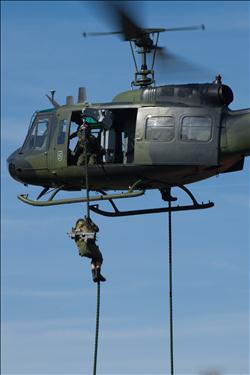
The Combat Enhancement and Force Integration Training (CET & FIT) phase of Exercise Green Blade/Pegasus is up to speed now. Special Forces from Belgium (Special Forces Group in Heverlee), Italy (IX Battaglione “Col Moschin” in Livorno) and Spain (Escuadrón de Zapadores Paracaidistas in Murcia and Fuerza de Guerra Naval Especial in Cartagena) continue improving their combat procedures and techniques through repeated training, evaluation and assessment. Interoperability of the different participants increases by mutually exchanging information on techniques, procedures and equipment.
 On Wednesday and Thursday 18 and 19 September, aircrews continued their familiarisation briefings and flights as well as night flying exercises. All these flights started and ended at Kleine-Brogel Air Base, which acts as Deployed Operating Base (DOB) in the scenario of Exercise Green Blade/Pegasus. A DOB provides air support to combat operations from an air base or airfield at a more or less safe location near or in the area of operations. All flights were conducted at a minimum altitude above ground level (AGL) as a noise abatement precaution. In dedicated Helicopter Training Areas (HTA), mostly sparsely populated areas, the helicopters, were allowed to fly below 250 ft AGL and to perform landings in predetermined landing zones. Crews who already performed local area orientation flights, started supporting the cross-training of the Special Forces from a small airfield near the Leopoldsburg Barracks: locally known as Sanicole Aero Club.
On Wednesday and Thursday 18 and 19 September, aircrews continued their familiarisation briefings and flights as well as night flying exercises. All these flights started and ended at Kleine-Brogel Air Base, which acts as Deployed Operating Base (DOB) in the scenario of Exercise Green Blade/Pegasus. A DOB provides air support to combat operations from an air base or airfield at a more or less safe location near or in the area of operations. All flights were conducted at a minimum altitude above ground level (AGL) as a noise abatement precaution. In dedicated Helicopter Training Areas (HTA), mostly sparsely populated areas, the helicopters, were allowed to fly below 250 ft AGL and to perform landings in predetermined landing zones. Crews who already performed local area orientation flights, started supporting the cross-training of the Special Forces from a small airfield near the Leopoldsburg Barracks: locally known as Sanicole Aero Club.
 During this cross-training, troopers of all three participating nations rehearsed fast-roping and the use of SPIERIG, by day as well as at night. Fast-roping is a technique for descending a thick rope and is most convenient for deploying personnel from a helicopter in places where the helicopter itself cannot land, like built-up areas and woodland. It was developed by the British and first used in combat during the Falklands War. The technique is quicker than rappelling, but also more challenging as the person is not attached to the rope with a descender. The person just holds onto the rope with his gloved hands and feet and slides down. The rope has to be thick to prevent it from being blown around in the helicopter’s rotor blast.
During this cross-training, troopers of all three participating nations rehearsed fast-roping and the use of SPIERIG, by day as well as at night. Fast-roping is a technique for descending a thick rope and is most convenient for deploying personnel from a helicopter in places where the helicopter itself cannot land, like built-up areas and woodland. It was developed by the British and first used in combat during the Falklands War. The technique is quicker than rappelling, but also more challenging as the person is not attached to the rope with a descender. The person just holds onto the rope with his gloved hands and feet and slides down. The rope has to be thick to prevent it from being blown around in the helicopter’s rotor blast.
SPIERIG or Special Purpose Insertion/Extraction Rig is equipment developed by the US Marines to rapidly insert or extract personnel from terrain where a helicopter cannot land. To pick up personnel, a SPIE rope is lowered from a hovering helicopter into the pickup area. The troopers, wearing a harness with a carabiner, hook up to a D-ring inserted in the SPIE rope and secure themselves with a second safety line that is attached to a second D-ring in the rope. The helicopter then climbs vertically until rope and personnel are clear of obstacles and proceeds in forward flight to a secure insert zone. The extracted persons then board the helicopter or are picked up by other means of transport.
In the past years, night flying became less hazardous by the use of Night Vision Goggles (NVG), but not less challenging. NVGs are optical instruments worn by pilots and other aircrew on their helmet and produce images in levels of light almost approaching total darkness. They were first used in World War II and came into wide use during the Vietnam War. Although NVGs make night flying less hazardous, the military always take a number of safety precautions into account. The helicopter’s Identification Friend or Foe (IFF, a system allowing identifying an aircraft on a radar screen), navigation and landing lights, and radar altimeter (a kind of radar allowing determining an aircraft’s altitude) have to be serviceable. Pilots have to respect the minima for visibility, ceiling and illuminance as specified in their national regulations, and for emergency procedures, a detailed fuel calculation has to be executed. The multinational “Best Practice Helicopter Tactics Workshop" that took place on Thursday delivered a valuable exchange of information on important items like the mission planning cycle, NVG flying experience using different system setups, MEDEVAC and SOF tactics, and sequence and contents of briefings.
More pictures are available on Flickr; several Green Blade videos are available on YouTube.